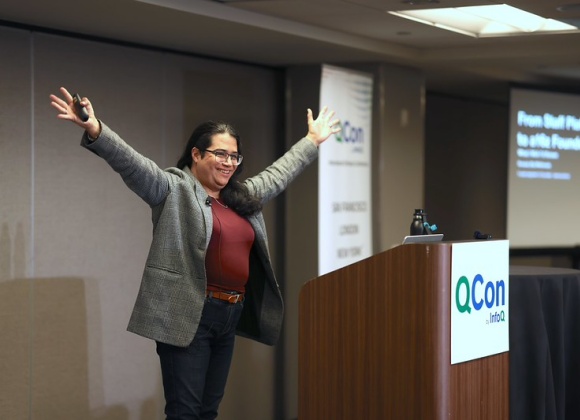In this podcast recorded at the Agile 2018 conference Shane Hastie, Lead Editor for Culture & Methods, spoke to Anna Obukhova about the neuroscience and biology of leadership and what it takes to coach and work with tired teams.
Key Takeaways
- When we change a process we also impact and cause change to the body and brain of the people involved in the process
- Behavioral ethology shows how the perception of being in a “caged environment” impacts hormone production and results in changed attitudes and approaches
- Energy levels vary from person to person and over time; maintaining high energy is crucial to leading and adapting to change
- Tired teams need different styles of coaching and support, using the same techniques as with energized teams can result in harm
- Different agile approaches and frameworks are applicable with companies and teams who have different energy levels, trying to apply a high energy framework in low energy environment will fail and cause stress
Subscribe on:
Show Notes
- 00:30 Introductions
- 01:44 When we change a process we also impact and cause change to the body and brain of the people involved in the process
- 02:03 Anna’s background in embryology and how that applies to her thinking about change
- 02:35 Introducing neuro leadership -
- 03:19 Discussing the biology of leadership
- 03:25 In the modern business world we don’t need leaders and followers, we need leaders and leaders
- 04:20 Drawing on behavioural ecology and exploring how the perception of being in a “caged environment” impacts hormone production and results in changed attitudes and approaches
- 05:23 Being “caged” results in feeling physically old – low energy and feeling incapable
- 05:56 This results in a need to protect one’s position and results in dominant behavior
- 06:14 The result of dominant behavior is bad management
- 06:25 Change resistance is a consequence of low energy and need for dominance
- 06:40 Anger is a short-term fix for low energy levels because it releases adrenalin, testosterone and dopamine
- 06:57 Contrasting leaders who don’t feel caged, they protect the team around them, they feel energetic
- 07:05 Mirror neurons result in the attitudes being visible and reflecting in people around the dominant or servant leader
- 07:35 We choose to follow leaders rather than dominant managers
- 07:55 How leadership results in others choosing to join and follow
- 08:32 It is possible to identify what makes leaders effective from an energy system/neuroscience perspective
- 08:48 Rank potential – the number of dopamine receptors in the brain – is one of the factors which influences curiosity and ambition
- 09:10 An example of how rank potential plays out in people
- 09:54 Exploring this idea with agile coaches and their perceived “size” of influence
- 11:03 Addiction of any sort impacts the dopamine system and hijacks curiosity and ambition
- 11:40 The result authorizing system is established in early childhood, up to approx. 6-8 years of age
- 12:07 Getting pleasure from group results comes from a different part of the brain and different chemical reactions (oxytocin)
- 12:32 Primitivity – the level of concern we have for our own goals vs the goals of our group/society – is another factor influencing leadership potential.
- 13:26 The third factor is vitality – the level of energy that you are able to maintain over long periods
- 13:54 Contrasting the different levels of the brain – reptile, limbic and higher brain. To engage the higher brain centres, you need higher energy levels
- 14:22 Exploring energy levels on a 0-100% scale
- 14:27 The average energy level for an office worker is around 33% – at this level any change results in internal panic
- 14:40 The minimum level of energy needed to be able to cope in an agile environment is 45%
- 15:09 This energy gap helps explain change resistance and failed agile adoption
- 15:14 Leaders need 50-55% energy level, and agile coaches need to have 60% or more to be effective
- 15:28 The differences in attitude that exhibit at higher energy levels, particularly around flexibility in thinking and tolerance
- 16:20 Maintaining energy levels is crucial for coaches; ways to keep your energy high include meditation, healthy diet, sleep patterns, exercise
- 16:58 The impact of losing energy levels on leaders
- 17:28 Many of the ways to raise energy levels are in the hands of the individual – exercise, sleep etc
- 17:39 Trying to coach a burned-out person using the common coaching techniques does more harm than good; working with tired, burned out people requires different approaches
- 18:40 Anna is researching ways to coach tired teams and help them maintain an agile approach while overcoming burnout
- 19:14 An example of one technique for a scrum master to work with a tired team
- 20:50 Anna has found over 40 techniques to work with tired teams
- 22:20 Anna’s workshop Coaching a Tired Team (presentation on InfoQ) and Brain Loves Agile website
- 22:58 Different agile frameworks are more applicable with teams and organisations working with different levels of energy
- 23:15 Make sure you apply appropriate approaches based on the organisation’s energy level – a mismatch will result in failure and stress on the people
Mentioned:
- Agile 2018
- David Rock’s NeuroLeadership Institute
- Coaching a Tired Team talk
- Brain Loves Agile website



